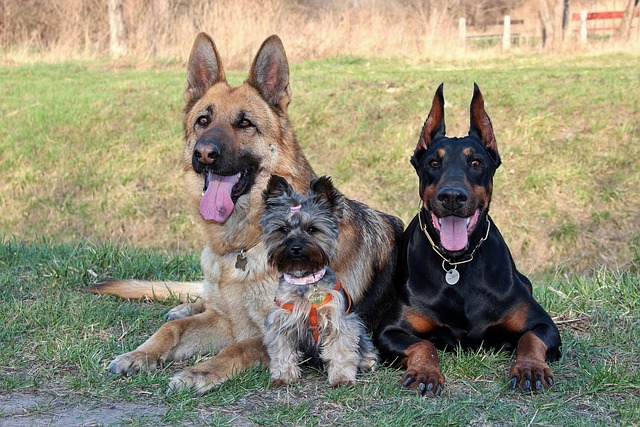Friendly Dog Breeds
Friendly dogs have far outstripped humans in the rate of increase. From just the 1930s to the 1960s their numbers in the United States multiplied to four times what they were, whereas the human population did not even double.
New York City has a half million dogs, yet that is far behind London’s 700,000 and Mexico City’s one million. While a few are vicious-about 25,000 dog bites were reported in New York City in 1969-the great majority are friendly. Does that mean all friendly dogs are safe?
From the way some persons treat them, it would seem they think so. They do not hesitate to pet practically every friendly dog they see, or even allow it to lick their hands or face. Is this a wise practice?
Not All friendly dogs are Safe Friendly Dog Breeds
Dogs sometimes come in contact with poison ivy, getting the plant’s irritating oils in their hair. Have you ever petted such a dog and later broken out with poison ivy? Cases of this affliction have been traced to a dog. Also, some persons with allergies have found that a dog will cause them discomfort. When the dog is removed, they realize relief.
Dogs can also get ringworm and may spread the fungi causing this skin disease to humans by contact. As The Complete Dog Book, an official publication of the American Kennel Club, notes: “Children who associate with affected dogs frequently become infected.” So dogs, even though they may be friendly, can be carriers of this highly contagious, although not serious, disease.
Rabies, on the other hand, is the most dreaded of diseases. It is usually transmitted to humans by a dog bite, although the bite of other animals can also infect one. In the early stages a rabid dog may appear even more friendly than usual. But the dog may easily become irritated and, if picked up, may bite and transmit a disease almost certainly fatal.
Then there are dogs that may be friendly but that have fleas that are not. These fleas will attack humans too, and they can carry disease. Thus, Dr. Deane P. Furman, an expert on parasitology, urges regarding fleas: “Every householder should get rid of these pests as quickly as possible.”
Clearly, not all dogs are safe. Discussing bacterial and fungus infections to which they are subject, The New Dog Encyclopedia (1970) said: “Many of these diseases are of public health importance since they affect other animals and man. One must be especially careful with infected animals around children, the aged, or persons who through other illness are in a state of lowered resistance.”
Dog Wastes-a Source of Disease?
As the number of friendly dogs increases, so do their wastes. A large dog will eliminate a pound and a quarter of feces a day, but the average for all friendly dogs is about three-quarters of a pound. That amounts to over 60,000 tons of solid wastes a year from just New York city dogs, and that does not include millions of gallons of urine! Can these wastes cause disease?
Yes, they can. For example, they can spread leptospirosis, which in humans is usually called Weil’s disease or rat fever. It is estimated that 50 percent of all dogs in the world have been stricken with leptospirosis at one time or another. Humans can become infected by contact with dog excretions, especially urine. Commenting on the disease, Preventive Medicine and Public Health, edited by Philip E. Sartwell, observes:
“Leptospirosis is worldwide in distribution. As clinical awareness has increased and as laboratory diagnostic methods have been more commonly employed, it has become evident that human leptospirosis is much more common than was formerly thought. Because of the diversity of clinical manifestations in the milder forms of the disease without jaundice, it will escape detection unless sought with laboratory aid. Clinical findings may be limited to the abrupt onset of fever with chills, headache, vomiting and pains in the extremities, joints, and muscles. Recovery occurs within a week to ten days.”
Friendly dogs Friendly Dog Breeds
In some places, friendly dogs also become infected with tapeworms belonging to the genus Echinococcus. The eggs of these worms are expelled in dog feces. Persons who pet contaminated dogs, or are licked by them, can get these microscopic eggs on their hands, and if they are ingested they can cause hydatid disease or hydatidosis. Cattle and swine are ravaged by this disease in Uruguay, and some 500 human cases of hydatidosis are diagnosed there a year, and about fifty persons die.
Hydatid disease extends through southern South America, South Australia, Tasmania, New Zealand, Africa, and the Middle East, where it more or less frequently occurs in man There is a surprisingly high prevalence of the disease in the Eskimo and Indian population of Canada, but it is rare lower in North America.
Dogs get these tapeworms by eating the internal organs of infected cattle or swine, which have the tiny heads of the little worms. These heads become attached to the walls of the dog’s intestines and grow to adulthood, reaching no more than a quarter of an inch in length. A dog can play host to many thousands of these adult worms, and eliminate a million of their eggs a week!
If these eggs are ingested by an intermediate host-such as humans, cattle or swine-they hatch in the intestines, penetrate the intestine walls and travel to various organs and tissues, particularly the liver. There a hydatid cyst forms, wherein the embryo develops into the tapeworm head. Although an adult worm does not form in an intermediate host, the formation of cysts can sicken or even kill the host, whether man or animal.

